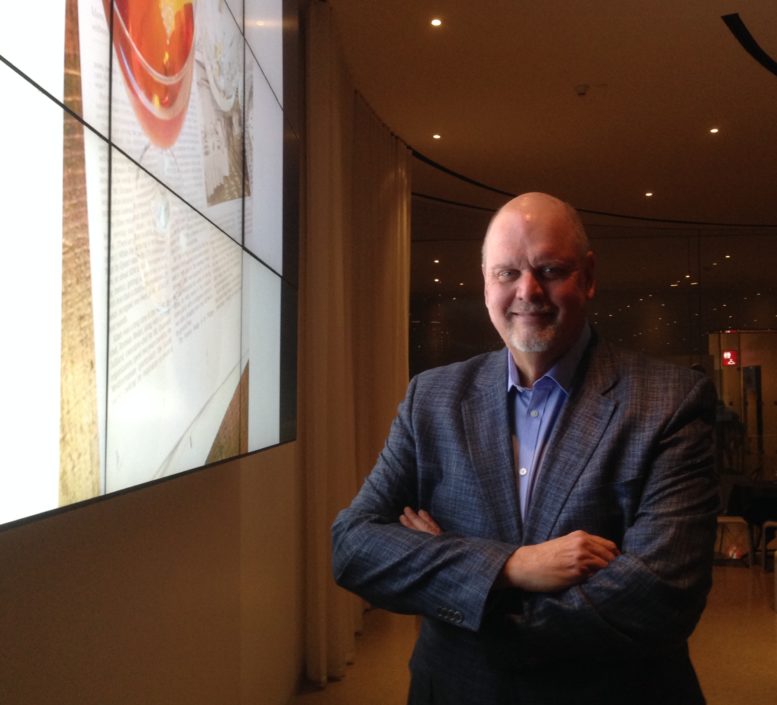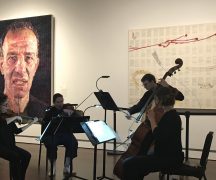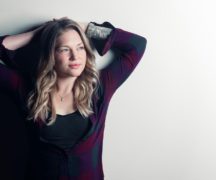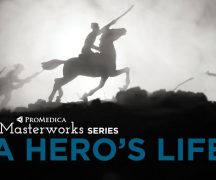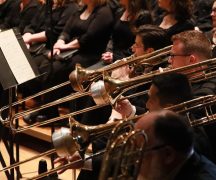By DAVID DUPONT
BG Independent News
The Hearst Castle in California has an organ.
Composer Michael Daugherty told an audience at the Toledo Museum of Art he’s never heard it. He does know that it was used to accompany the showing of the silent films that William Randolph Heart’s mistress Marion Davies starred in. Hearst would round up his guests into the theater to watch the films, and he had people who would go and rouse anyone who dozed off.
That’s the kind of detail Daugherty as a lover of American culture savors. Scott Boberg, the museum’s manager of programs and public engagement, said the composer’s work is “a comprehensive exploration of American culture and geography.” He’s written works inspired by Route 66 and the Brooklyn Bridge, Superman and Elvis Presley, the paintings of Grant Wood and Georgia O’Keefe, and the Detroit Industry murals of Diego. “You get a sense of America.”
Daugherty said he’s been to the Hearst Castle at least 10 times. He’s fascinated by the structure, with its enormous Neptune pool as well as the glittering Hollywood era it represents. When he received a commission to write a concerto for organ and orchestra he decided this would be the right occasion to celebrate Hearst, his castle, and Orson Welles’ classic film “Citizen Kane,” an acerbic portrait of the media mogul.
The Toledo Symphony Orchestra is playing the concerto this weekend on a program that includes another American work inspired by a castle “Xanadu” by Charles Griffes and a masterwork for orchestra Bela Bartok’s Concerto for Orchestra.
The Toledo Museum of Art programmed the “Citizen Kane Experience” around the orchestra’s performance of Daugherty’s piece (Friday and again Saturday night at 8). It started on Thursday night with a screening of “Citizen Kane” and included “Once Upon a Cocktail” reception before Friday night’s performance.
Daugherty was on hand for the reception, where guests sipped cocktails – the Hearst Cocktail, Bee’s Knees and Highball – fashionable from Hearst’s time.
Not that Hearst’s guests would have imbibed heavily in them. Daugherty said the tycoon restricted his guest to one drink a night. Errol Flynn was tossed from the castle for bringing his own booze.
Hearst was a collector. He was so acquisitive, some of his purchases were never uncrated. Some of the objects he bought have ended up in the Toledo Museum’s collection. Jutta Page, associate curator, described them, and how she recently came to realize that a large table in the collection had been owned by Hearst.
An archivist, who was trying to locate a fireplace from an English castle, sent her a photo. Page was able to determine the fireplace was the one being sought, then she realized the table in the photo was in the Toledo Museum’s collection.
Daugherty noted that though Hearst lived at a time when American art, architect and music was blossoming, he like most of his fellow magnates, had no interest in it.
The castle was designed to look like a European structure, even as Frank Lloyd Wright was making his mark designing Fallingwater.
In his composition “Once Upon a Castle” Daugherty said he “riffs off music of the past.” In the third movement “Rosebud,” the name of Citizen Kane’s boyhood sled, Daugherty evokes the music composed for the film by Bernard Herrmann in a duet between the organ played by Paul Jacobs and a solo violin played by concertmaster Kirk Toth.
The movement evokes a scene in the movie of Kane and his mistress bickering from opposite sides of a massive room. Here Kane is represented by the organ, large, powerful, overbearing, while the woman’s side is taken by the solitary violin.
“Once Upon a Castle” is kaleidoscopic, making full use of the colors of the organ and orchestra. In the last section, “Xanadu,” meant to evoke one of the wild parties at the castle, the music has Jacobs almost dancing on the organ’s pedals.
The pairing of organ and orchestra presents challenges, Daugherty said. The organ really is an orchestra unto itself. With its pipes flanking the Peristyle stage, the Skinner organ wraps around the orchestra. In “Once Upon a Castle” the two entities converse as equals. Daugherty noted he did not use oboe, bassoon or clarinet because they were too close to the organ’s own reed sounds.
Jacobs praised Daugherty’s facility at writing for the organ. The composer said he spent many nights at Hill Auditorium in Ann Arbor working with an organist to refine the composition.
The piece appears on the Grammy-nominated recording “Tales of Hemingway” on the Naxos label with Jacobs as soloist.
Jacobs (who will perform a solo recital Sunday at 2:30 p.m.) has championed the piece. He’s performed it many times. A composition of this quality, he said, demands to be heard.

